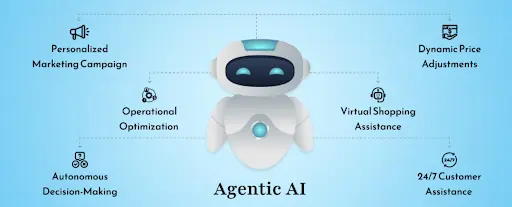How Using Agentic AI in E-commerce Gets Better Conversions

Your dashboards say traffic is up, yet nearly seven in ten shoppers still abandon their carts. Marketing throws discounts at the problem; ops scrambles to match stock with unpredictable demand. The result is profit margins squeeze and a growth ceiling that feels closer every quarter.
Deploying agentic AI tackles the issue where traditional e-commerce tools struggle. Picture an autonomous agent that spots a hesitating buyer, bundles a just-right offer, checks real-time inventory, and arranges same-day fulfilment. Early adopters see revenue lifts of 10-15% thanks to such personalised, goal-driven interventions.
AI agents learn, plan, and act at machine speed. In this blog, we’ll explore how these agents reduce choke-points across merchandising, pricing, and service, and what it takes to weave them into your stack without disrupting the quarter.
The Impact of Agentic AI on E-Commerce
Agentic AI in e-commerce is one of the most fascinating fields right now for both founders and venture capitalists, as it brings us closer to the ideal human-technology interaction.

Let’s see how AI automation is leveraged to shape the modern e-commerce journey.
AI-powered personalisation
What happens when agentic AI is used to connect customers through personalisation? The proactive, customised notifications engage consumers and meet them where they are. One powerful application of this is agent-based recommendation engines, which use autonomous decision-making to suggest exactly what users want, often before they know it themselves.
A brilliant example of this type of product is being built by a company called Aampe. Their personalised shopping AI system makes sure that customers always have the best, most tailored e-commerce experiences.
With stricter rules on third-party cookie use and consumer data privacy, startups like this are ready to take over a big and essential part of consumer interaction and welcome a new era of unique, "pull-you-in" experiences.
GrowthJockey’s intellsys.ai platform plugs the same agent-based recommendation engines straight into Shopify without code, letting merchandisers launch personalised shopping AI in days.
Smarter 24/7 customer support
Most traditional AI chatbots are like customer service on autopilot. They follow a script, and they usually hit a wall when the conversation goes off track. But agentic AI in e-commerce is entirely different.
These autonomous e-commerce systems can figure out when a problem’s getting serious or even negotiate with the customer on your behalf.
We're talking about things like automatically offering a tailored refund or an extra discount based on a customer's value over time. Imagine intelligent customer support agents thinking, 'This person’s been with us for years and they're frustrated. Let’s fix this properly.' That’s the power of agentic AI in customer support.
Automated inventory and logistics
Agentic AI optimises inventory by analysing real-time sales data, regional demand, or seasonal shifts. It dynamically reallocates stock across warehouses and platforms, reducing both shortages and overstock.
For example, Zara uses AI-driven inventory management systems to sense local demand spikes and quickly shift inventory across stores. This ensures fast turnaround without excess stock.
Proactive inventory optimisation using AI cuts holding costs, improves product availability, and keeps fulfilment agile. It’s a smarter way to manage stock in a fast-moving market.
AI-powered autonomous merchandising
Traditional A/B testing offers limited insights in fast-moving markets. AI in digital storefront management takes it further. Agentic systems continuously adapt layouts, banners, and product placement based on real-time user behaviour and sales trends.
They respond instantly to what’s working - no waiting, no manual tweaks. Layered with dynamic pricing algorithms, the system can adjust prices on the go, factoring in demand, competitor moves, and customer intent.
For example, during peak evening traffic, the AI automatically repositions trending items to the top of the page and fine-tunes prices to maximise conversions. This keeps your storefront responsive, competitive, and customer-focused all the time.
Multichannel sales continuity
Most legacy chatbots live in a single channel. They can't move with the customer or carry over context. This can be improved with the deployment of agentic AI in e-commerce.
These agents stay active across touchpoints like your website, WhatsApp, Instagram DMs, Meta, email, and SMS. They remember past interactions, access real-time product data, and respond in a natural and relevant way.
The result? A seamless experience where customers can pick up the conversation anytime, anywhere, without starting over. This kind of continuity isn’t just nice to have as it drives results.
Did you know?
According to Salesforce, 76% of customers expect consistent interactions across departments and channels, but only 54% say they actually get that experience.
What are the Benefits of Agentic E-Commerce?
By 2027, Gartner predicts 70% of customer interactions will involve emerging technologies like AI agents. Agentic e-commerce won't replace your team, it will rather develop systems that learn your business, adapt in real time, and create new avenues to speed, scale, and customer insight.

Here are some of its benefits:
- Built to scale
Autonomous e-commerce systems grow with your goals. The more the agents know about your operations, the more they use their intelligence to change in real time, enhancing productivity or building new agents to undertake far more complex tasks.
- Less friction, more action
Imagine an interface where you issue a prompt, watch the action, and concentrate without the help of a second tool, creating constant context switching. That's what agentic AI in e-commerce does.
- Personalisation that works
Agents use your data to support responsive, high-trust customer experiences on demand.
In fact, McKinsey reports that companies using AI-driven personalisation see up to a 40% increase in revenue from those activities. This is because the experiences feel timely, relevant, and deeply aligned with what customers actually want.
- Speed with substance
With autonomous e-commerce systems, product updates, pricing, and campaigns move faster, thus allowing your team to focus on strategy more than on execution.
3 Real E-Commerce Businesses Using Agentic AI to Sell Smarter
70% of respondents to a recent Coveo and SAP-sponsored Harvard Business Review study stated that integrating AI beyond generative AI into their e-commerce operations is highly or extremely critical to their e-commerce strategy.
Let’s see how businesses in real world are integrating agentic decision-making in retail:
1. Amazon ‘Buy for Me’
Amazon’s new “Buy for Me” assistant signals a major leap in personalised shopping AI. Built into the Amazon app, this agentic feature goes beyond recommendations; it searches third-party sites, places orders, and completes transactions on the user’s behalf.
It’s a shift from passive browsing to autonomous, goal-driven shopping, where intent meets instant action.

2. IKEA’s visual search
IKEA’s mobile app combines AI and AR to make home shopping effortless. Its visual search feature lets users snap a photo of a chair, lamp, or table they spot anywhere, and instantly find similar products from IKEA’s range, without the need for text searches.
This powerful “point-and-shop” experience is powered by GrokStyle, a startup that raised $2 million for its visual recognition tech and landed IKEA as its first major customer.
3. Sephora Virtual Artist
Sephora Virtual Artist was widely hailed as an innovative and accessible mobile experience in the beauty tech industry.
Using AR, the app enabled users to digitally try on thousands of products, providing a personalised and interactive experience. In only two years post-launch, over 200 million product shades were tried through the application, while visits hit 8.5 million.
What Does the Future of Agentic AI in E-Commerce Look Like?
As e-commerce enters a new growth phase, agentic AI redefines how brands drive conversions, personalise experiences, and streamline operations.
-
From voice-enabled shopping to dynamic UX optimisation, autonomous agents are handling tasks that once required manual input.
-
With privacy rules tightening, these agents use zero-party data to deliver ethical, high-impact personalisation.
-
Marketers can now deploy and manage intelligent agents through no-code tools, accelerating innovation.
-
With multi-agent workflows in retail, complex processes such as product discovery and post-purchase follow-up can run in sync. This will lead to smarter, more connected customer journeys across every touchpoint.
Navigating the Uncertainties of Agentic AI in E-Commerce
Agentic AI sounds powerful, but also a bit unpredictable. The space is evolving quickly, and it’s not always clear where to start or how to apply it to real business problems. But even in this early stage, the impact is already visible:
-
Brands are using AI-powered product discovery to surface relevant items in real time, improving conversions without added manual effort.
-
With agentic decision-making in retail, businesses are automating pricing, recommendations, and customer support based on live data, not static rules.
-
Teams are finding that small, focused pilots build trust and clarity faster than overhauling everything at once.
-
The smartest approach? Start with use cases that directly relate to customer experience or revenue, and scale from there.
Learn more about the challenges leaders around the world are facing with agentic AI
Agentic AI Across Different Industries
Agentic AI is fundamentally reshaping various industries by enabling intelligent, autonomous decision-making. Explore how it's being applied across sectors like healthcare, retail, education, legal, and more to drive innovation and efficiency.
Agentic AI Across Different Industries
Agentic AI is fundamentally reshaping various industries by enabling intelligent, autonomous decision-making. Explore how it's being applied across sectors like healthcare, retail, education, legal, and more to drive innovation and efficiency.
Leverage E-Commerce Automation for your Business with GrowthJockey
Developing a strategy for agentic AI in e-commerce can feel overwhelming, and that’s completely normal. In fact, 76% of IT leaders say their organisations have yet to achieve AI maturity, highlighting a real gap between goals and execution.
The technology may be new, but the challenges like scaling operations, improving personalisation, and increasing responsiveness are familiar. What’s changed is the speed and intelligence with which agentic AI can now tackle them.
At GrowthJockey, we make agentic AI work for your e-commerce business, without the overload. From shaping the right strategy to building smart, self-learning agents, we help you move faster, sell smarter, and scale with ease.
FAQs on Agentic AI in E-Commerce
1. How does agentic AI cut cart abandonment in online stores?
Autonomous e-commerce systems track exit intent, then launch personalised shopping AI that offers micro-discounts, faster shipping, or live chat support. By matching incentives to shopper value in real time, brands routinely trim abandonment by 20% or more.
2. Can dynamic pricing algorithms hurt customer trust?
When powered by agentic decision-making in retail, dynamic pricing algorithms update transparently, showing “limited-time match” or “loyalty price” labels. This clarity pairs price agility with fairness, keeping margins healthy without sparking backlash.
3. How is inventory optimisation using AI different with agentic tech?
Traditional tools reorder on static thresholds. Agentic AI analyses sell-through, returns, and regional demand every few minutes. Agents then rebalance stock across warehouses, cutting overstock and out-of-stock events by double-digit percentages.
4. What makes agent-based recommendation engines better than rules-based ones?
Rules suggest “people also bought.” Agent-based recommendation engines learn each shopper’s intent, seasonality, and real-time signals, then assemble bespoke bundles. The result is higher AOV and stronger lifetime value compared with static cross-sell lists.








